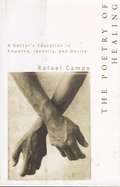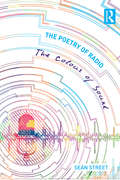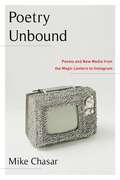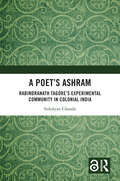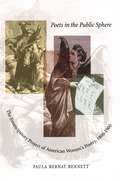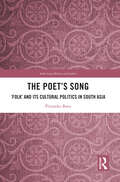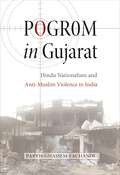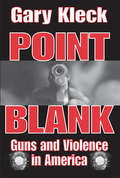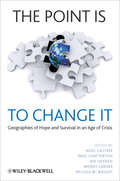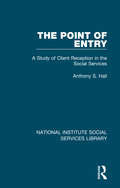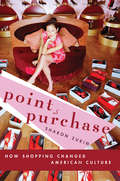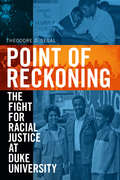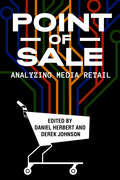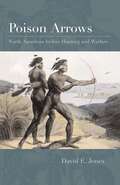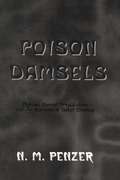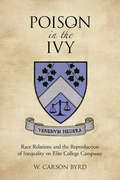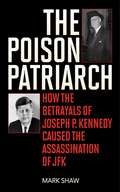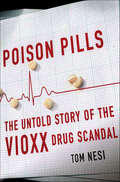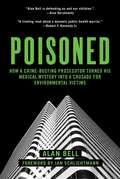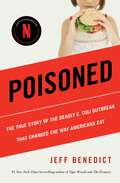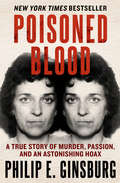- Table View
- List View
The Poetry of Healing: A Doctor's Education in Empathy, Identity, and Desire
by Rafael CampoBack Cover: The healing powers of speech, of touch, of empathy and the erotic, of love itself--these are some of the themes of Rafael Campo's deeply humanistic work as he writes not just of his attempts to heal, but of how his patients healed him. From Campo's arresting first chapter, one is in the hands of the writer who bridges the clinical distance of medicine to face the pain of mortality, the brokenness of society, and the unique and vulnerable beauty of human beings. His work, the Los Angeles Times said, is "reminiscent of Chekhov... [in] the way language comes up out of the body."
The Poetry of Radio: The Colour of Sound
by Seán StreetThis book explores the idea of the poetic in radio and sound as well as the concept of pure sound as poetry, both historically and within a contemporary perspective, examining examples of makers and works internationally. The work examines the development of poetic forms in sound broadcasting historically and geographically through chapters taking narrative themes. It includes primary source material gathered through interviews conducted by the author with distinguished producers and poets. Among these are producers Piers Plowright, Matt Thompson, Alan Hall, Simon Elmes and Julian May (UK) Edwin Brys, (Belgium) Hildegard Westerkamp (Germany/Canada) Chris Brookes (Canada) Robyn Ravlitch, Michael Ladd and Kaye Mortley (Australia) as well as poets, including Michael Symmons Roberts and Jeremy Hooker. There is a chapter on the poetic sound in the natural world, which focuses in particular on the work of the renowned UK sound recordist, Chris Watson. Alongside audio poetry, the book discusses the spoken word including documentaries and public announcements, the radio feature, soundscapes, sonic art with contributions from key figures such as Colin Black (Australia) and Marcus Leadley (UK)and the poetry of the vernacular in speech and sound. It considers new platforms for listening including podcasts and developments in mobile technologies, examining the work of current practitioners including Francesca Panetta, who is responsible for The Guardian's podcasts as well as the award-winning Hackney Podcast, and Tim Wright.
Poetry Unbound: Poems and New Media from the Magic Lantern to Instagram
by Mike ChasarIt’s become commonplace in contemporary culture for critics to proclaim the death of poetry. Poetry, they say, is no longer relevant to the modern world, mortally wounded by the emergence of new media technologies. In Poetry Unbound, Mike Chasar rebuts claims that poetry has become a marginal art form, exploring how it has played a vibrant and culturally significant role by adapting to and shaping new media technologies in complex, unexpected, and powerful ways.Beginning with the magic lantern and continuing through the dominance of the internet, Chasar follows poetry’s travels off the page into new media formats, including silent film, sound film, and television. Mass and nonprint media have not stolen poetry’s audience, he contends, but have instead given people even more ways to experience poetry. Examining the use of canonical as well as religious and popular verse forms in a variety of genres, Chasar also traces how poetry has helped negotiate and legitimize the cultural status of emergent media. Ranging from Citizen Kane to Leave It to Beaver to best-selling Instapoet Rupi Kaur, this book reveals poetry’s ability to find new audiences and meanings in media forms with which it has often been thought to be incompatible. Illuminating poetry’s surprising multimedia history, Poetry Unbound offers a new paradigm for understanding poetry’s still evolving place in American culture.
A Poet’s Ashram: Rabindranath Tagore’s Experimental Community in Colonial India
by Sukalyan ChandaThe remarkably creative life Rabindranath Tagore (1861–1941) lived has long been an area of scholarly enquiry. Yet, surprisingly, his role as the founder of an experimental ashram community remains unexplored. A Poet’s Ashram retrieves his idea of his ashram through an exploration of his writings on the institutions he built.The ashram community Tagore endeavoured to create in Santiniketan during the period 1901–1941 was his response to the question of modernity. Through his effort to reinvent the ancient Indian ideal of the ashram, he articulated his idea of a mode of collective living that was meant to be grounded in a set of ethical values derived from India’s civilizational inheritance. This book traces the history of how his ashram school evolved into a community that practised egalitarianism, inclusiveness and creativity through its daily existence. It explores a range of nineteenth- and twentieth-century discourses and Tagore’s engagement with them in order to situate that idea within its historical context, a critical juncture in the history of modern India and the world. This book’s reading of his project unravels its anti-colonial underpinnings and the commonalities it shared with some of the other similar experimental communities that challenged illiberal ideologies and power relations during the early twentieth century.Meticulously researched and perceptively written, this book will be of interest to students and researchers of history, political science, culture studies and postcolonial studies. It will also be of interest to educationists, educators and those interested in colonial modernity, modern Indian history, philosophy of education, institution building, peace, inclusivity and sustainability.
Poets in the Public Sphere: The Emancipatory Project of American Women's Poetry, 1800-1900
by Paula Bernat BennettBased entirely on archival research, Poets in the Public Sphere traces the emergence of the "New Woman" by examining poetry published by American women in newspapers and magazines between 1800 and 1900. Using sources like the Kentucky Reporter, the Cherokee Phoenix, the Cincinnati Israelite, and the Atlantic Monthly, Bennett is able to track how U.S. women from every race, class, caste, region, and religion exploited the freedom offered by the nation's periodical press, especially the poetry columns, to engage in heated debate with each other and with men over matters of mutual concern. Far from restricting their poems to the domestic and personal, these women addressed a significant array of political issues--abolition, Indian removals, economic and racial injustice, the Civil War, and, not least, their own changing status as civil subjects. Overflowing with a wealth of heretofore untapped information, their poems demonstrate conclusively that "ordinary" nineteenth-century women were far more influenced by the women's rights movement than historians have allowed. In showing how these women turned the sentimental and ideologically saturated conventions of the period's verse to their own ends, Bennett argues passionately and persuasively for poetry's power as cultural and political discourse. As much women's history as literary history, this book invites readers to rethink not only the role that nineteenth-century women played in their own emancipation but the role that poetry plays in cultural life.
The Poet’s Song: ‘Folk’ and its Cultural Politics in South Asia (South Asian History and Culture)
by Priyanka BasuThis book explores the ‘folk’ performance genre of Kobigaan, a dialogic song-theatre form in which performers verse-duel, in contemporary West Bengal in India and Bangladesh. Thought to be a nearly extinct form, the book shows how the genre is still prevalent in the region. The author shows how like many other ‘folk’ practices in South and South-East Asia, the content and format of this genre has undergone vital changes thus raising questions of authenticity, patronage and cultural politics. She captures live performances of Kobigaan through ethnographies spread across borders — from village rituals to urban festivals, and from Bengali cinema to television and new media. While understanding Kobigaan from the practitioners’ points-of-view, this book also explores the crucial issues of gender, marginalization and representation that is true of any performance genre. Drawing on case studies, it underlines the issues of artistic agency, empowerment, cultural labour and heritage, ritual, authenticity, creative industries, media, gender, and identity politics. Part of the ‘South Asian History and Culture’ series, this book is a major intervention in South Asian folklore and performance studies. It also expands into the larger disciplines of literature, social and cultural movements in South Asia, ethnomusicology and the politics of performance.
Pogrom in Gujarat: Hindu Nationalism and Anti-Muslim Violence in India
by Parvis Ghassem-FachandiIn 2002, after an altercation between Muslim vendors and Hindu travelers at a railway station in the Indian state of Gujarat, fifty-nine Hindu pilgrims were burned to death. The ruling nationalist Bharatiya Janata Party blamed Gujarat's entire Muslim minority for the tragedy and incited fellow Hindus to exact revenge. The resulting violence left more than one thousand people dead--most of them Muslims--and tens of thousands more displaced from their homes. Parvis Ghassem-Fachandi witnessed the bloodshed up close. In Pogrom in Gujarat, he provides a riveting ethnographic account of collective violence in which the doctrine of ahimsa--or nonviolence--and the closely associated practices of vegetarianism became implicated by legitimating what they formally disavow. Ghassem-Fachandi looks at how newspapers, movies, and other media helped to fuel the pogrom. He shows how the vegetarian sensibilities of Hindus and the language of sacrifice were manipulated to provoke disgust against Muslims and mobilize the aspiring middle classes across caste and class differences in the name of Hindu nationalism. Drawing on his intimate knowledge of Gujarat's culture and politics and the close ties he shared with some of the pogrom's sympathizers, Ghassem-Fachandi offers a strikingly original interpretation of the different ways in which Hindu proponents of ahimsa became complicit in the very violence they claimed to renounce.
Point Blank: Guns and Violence in America (Social Institutions And Social Change Ser.)
by Gary KleckBy 1990 there were approximately 200 million guns in private hands in the United States, and around half of American households contained a gun. Over 30,000 people a year are killed with guns in suicides, homicides, and accidents, and Americans use guns for defensive purposes as many as a million times a year. There is little doubt that gun violence and control are issues of vital importance, and they continue to inspire national debate. It is doubtful, however, that most gun debates are worth listening to. Not surprisingly, they generally leave their participants exactly where they began, with their biases intact, and onlookers perplexed. Written deliberately to counter an atmosphere of hysteria and extremism, Point Blank, now in paperback, offers logical argument supported by empirical information. It confronts fundamental questions head-on. On its initial publication in 1993, Point Black won the Michael J. Hindelang Award of the American Society of Criminology for the book that "made the most outstanding contribution to criminology," Point Blank reports both original research and assesses existing evidence drawn from a wide variety of academic disciplines, including criminology, sociology, law, and medicine.
The Point Is To Change It: Geographies of Hope and Survival in an Age of Crisis (Antipode Book Series #38)
by Noel Castree Paul Chatterton Nik Heynen Wendy Larner Melissa W. WrightCommissioned to celebrate the 40th year of Antipode: A Radical Journal of Geography, this book evaluates the role of the critical social scientist and how the point of their work is not simply to interpret the world but to change it Brings together leading critical social scientists to consider the major challenges of our time and what is to be done about them Applies diagnostic and normative reasoning to momentous issues including the global economic crisis, transnational environmental problems, record levels of malnourishment, never ending wars, and proliferating natural disasters Theoretically diverse - a range of perspectives are put to work ranging from Marxism and feminism to anarchism The chapters comprise advanced but accessible analyses of the present and future world order
The Point of Entry: A Study of Client Reception in the Social Services (National Institute Social Services Library)
by Anthony S. HallFew people who work in the social services would deny that the reception of those asking for help is important, and yet this process is seldom closely examined. Originally published in 1974, this book aims not only to focus attention on the problems faced by those seeking the help of a social service organisation, but also to analyse what happens and why at the point of entry. This study analyses reception practices in four very different social work agencies. The author demonstrates that the reception process is not just an administrative expedient but that, under certain circumstances, it may have a profound influence upon the way the agency operates, the services it provides and who receives them. In short, many of the important rationing decisions about resources allocation may be made not by an agency’s senior and middle managers, or by its professional social work staff, but by an untrained clerical receptionist at the point of initial contact between the organisation and its clients. The Point of Entry was primarily written for students and teachers of social administration, social workers, administrators, and receptionists themselves. It is, however, a valuable study for all who are concerned with the reception of visitors to any kind of organisation which provides a service to clients.
Point of Purchase: How Shopping Changed American Culture
by Sharon ZukinThis accessible, smart, and expansive book on shopping's impact on American life is in part historical, stretching back to the mid-19th century, yet also has a contemporary focus, with material on recent trends in shopping from the internet to Zagat's guides.Drawing inspiration from both Pierre Bourdieu's work and Walter Benjamin's seminal essay on the shopping arcades of 19th-century Paris, Zukin explores the forces that have made shopping so central to our lives: the rise of consumer culture, the never-ending quest for better value, and shopping's ability to help us improve our social status and attain new social identities.
Point of Reckoning: The Fight for Racial Justice at Duke University
by Theodore D. SegalOn the morning of February 13, 1969, members of Duke University's Afro-American Society barricaded themselves inside the Allen administration building. That evening, police were summoned to clear the building, firing tear gas at students in the melee that followed. When it was over, nearly twenty people were taken to the hospital, and many more injured. In Point of Reckoning, Theodore D. Segal narrates the contested fight for racial justice at Duke from the enrollment of the first Black undergraduates in 1963 to the events that led to the Allen Building takeover and beyond. Segal shows that Duke's first Black students quickly recognized that the university was unwilling to acknowledge their presence or fully address its segregationist past. By exposing the tortuous dynamics that played out as racial progress stalled at Duke, Segal tells both a local and national story about the challenges that historically white colleges and universities throughout the country have faced and continue to face.
Point of Sale: Analyzing Media Retail
by Daniel Herbert Derek Johnson Emily West Greg Steirer Heikki Tyni Olli Sotamaa Elizabeth Affuso Avi Santo Ethan Tussey Meredith A. Bak Courtney Brannon Donoghue Tim J. Anderson Lynn Comella Benjamin Woo Nasreen Rajani Erin Hanna Evan Elkins Marc SteinbergPoint of Sale offers the first significant attempt to center media retail as a vital component in the study of popular culture. It brings together fifteen essays by top media scholars with their fingers on the pulse of both the changes that foreground retail in a digital age and the history that has made retail a fundamental part of the culture industries. The book reveals why retail matters as a site of transactional significance to industries as well as a crucial locus of meaning and interactional participation for consumers. In addition to examining how industries connect books, DVDs, video games, lifestyle products, toys, and more to consumers, it also interrogates the changes in media circulation driven by the collision of digital platforms with existing retail institutions. By grappling with the contexts in which we buy media, Point of Sale uncovers the underlying tensions that define the contemporary culture industries.
Poison Arrows: North American Indian Hunting and Warfare
by David E. JonesBiological warfare is a menacing twenty-first-century issue, but its origins extend to antiquity. While the recorded use of toxins in warfare in some ancient populations is rarely disputed (the use of arsenical smoke in China, which dates to at least 1000 BC, for example) the use of “poison arrows” and other deadly substances by Native American groups has been fraught with contradiction. At last revealing clear documentation to support these theories, anthropologist David Jones transforms the realm of ethnobotany in Poison Arrows. Examining evidence within the few extant descriptive accounts of Native American warfare, along with grooved arrowheads and clues from botanical knowledge, Jones builds a solid case to indicate widespread and very effective use of many types of toxins. He argues that various groups applied them to not only warfare but also to hunting, and even as an early form of insect extermination. Culling extensive ethnological, historical, and archaeological data, Jones provides a thoroughly comprehensive survey of the use of ethnobotanical and entomological compounds applied in wide-ranging ways, including homicide and suicide. Although many narratives from the contact period in North America deny such uses, Jones now offers conclusive documentation to prove otherwise. A groundbreaking study of a subject that has been long overlooked, Poison Arrows imparts an extraordinary new perspective to the history of warfare, weaponry, and deadly human ingenuity.
Poison Arrows: North American Indian Hunting and Warfare
by David E. JonesA comprehensive survey of organic compounds used as poisons—on arrows and spears, in food, and even as insecticides—by numerous Native American tribes.Biological warfare is a menacing twenty-first-century issue, but its origins extend to antiquity. While the recorded use of toxins in warfare in some ancient populations is rarely disputed (the use of arsenical smoke in China, which dates to at least 1000 BC, for example) the use of &“poison arrows&” and other deadly substances by Native American groups has been fraught with contradiction. At last revealing clear documentation to support these theories, anthropologist David Jones transforms the realm of ethnobotany in Poison Arrows.Examining evidence within the few extant descriptive accounts of Native American warfare, along with grooved arrowheads and clues from botanical knowledge, Jones builds a solid case to indicate widespread and very effective use of many types of toxins. He argues that various groups applied them to not only warfare but also to hunting, and even as an early form of insect extermination. Culling extensive ethnological, historical, and archaeological data, Jones provides a thoroughly comprehensive survey of the use of ethnobotanical and entomological compounds applied in wide-ranging ways, including homicide and suicide. Although many narratives from the contact period in North America deny such uses, Jones now offers conclusive documentation to prove otherwise.A groundbreaking study of a subject that has been long overlooked, Poison Arrows imparts an extraordinary new perspective to the history of warfare, weaponry, and deadly human ingenuity.&“A unique contribution to the field of American Indian ethnology. . . . This information has never been compiled before, and I doubt that many ethnologists in the field have ever suspected the extent to which poison was used among North American Indians. This book significantly extends our understanding.&” —Wayne Van Horne, Associate Professor of Anthropology, Kennesaw State University
Poison Damsels
by PenzerFirst published in 2004. Routledge is an imprint of Taylor & Francis, an informa company.
Poison in the Ivy: Race Relations and the Reproduction of Inequality on Elite College Campuses (The American Campus)
by W. Carson ByrdThe world of elite campuses is one of rarified social circles, as well as prestigious educational opportunities. W. Carson Byrd studied twenty-eight of the most selective colleges and universities in the United States to see whether elite students’ social interactions with each other might influence their racial beliefs in a positive way, since many of these graduates will eventually hold leadership positions in society. He found that students at these universities believed in the success of the ‘best and the brightest,’ leading them to situate differences in race and status around issues of merit and individual effort.Poison in the Ivy challenges popular beliefs about the importance of cross-racial interactions as an antidote to racism in the increasingly diverse United States. He shows that it is the context and framing of such interactions on college campuses that plays an important role in shaping students’ beliefs about race and inequality in everyday life for the future political and professional leaders of the nation. Poison in the Ivy is an eye-opening look at race on elite college campuses, and offers lessons for anyone involved in modern American higher education.
The Poison Patriarch: How the Betrayals of Joseph P. Kennedy Caused the Assassination of JFK
by Mark ShawFocusing for the first time on why attorney general Robert F. Kennedy wasn’t killed in 1963 instead of on why President John F. Kennedy was, Mark Shaw offers a stunning and provocative assassination theory that leads directly to the family patriarch, Joseph P. Kennedy. Mining fresh information and more than forty new interviews, Shaw weaves a spellbinding narrative involving Mafia don Carlos Marcello; Jack Ruby (Lee Harvey Oswald’s killer); Ruby’s attorney, Melvin Belli; and, ultimately, the Kennedy brothers and their father.Shaw addresses these tantalizing questions: Why, shortly after his brother’s death, did a grief-stricken RFK tell a colleague, “I thought they would get one of us . . . I thought it would be me”? Why was Belli, an attorney with almost no defense experience (but proven ties to the Mafia), chosen as Jack Ruby’s attorney? How does Belli’s Mafia connection call into question his legal strategy, which ultimately led to the Ruby’s first-degree murder conviction and death sentence? What was Joseph Kennedy’s relationship to organized crime? And how was his insistence that JFK appoint RFK as attorney general tantamount to signing the president’s death warrant?For fifty years, Shaw maintains, researchers investigating the president’s murder in Dallas have been looking at the wrong motives and actors. The Poison Patriarch offers a shocking reassessment—one that is sure to alter the course of future assassination debates.
Poison Pills: The Untold Story of the Vioxx Drug Scandal
by Tom NesiTo the millions of Americans who suffer from chronic pain and arthritis, Vioxx seemed like a miracle. One of the most widely promoted and prescribed pain medications in the world -- used by more than twenty million people -- it was endorsed by the medical establishment and celebrities such as Olympic champion figure skater Dorothy Hamill. With annual sales of $2.5 billion, Vioxx became a pharmaceutical bonanza before being abruptly taken off the market in September 2004, after it was revealed that it led to an increased risk of heart-related disease and death.Drawing on internal documents, video footage, court testimony, and exclusive interviews, as well as three decades of experience inside the medical industry, Tom Nesi tells the dramatic story of what the drug's manufacturer, Merck, knew and when. It is a compelling narrative of business and medical science run amok, with a cast of characters ranging from those at the highest levels of the multibillion-dollar pharmaceutical industry to research scientists, marketers, and drug company sales reps. Here also are accounts from physicians, lawyers, financial analysts, and patients and their families whose lives have been forever altered by Vioxx.Set against a fascinating history of the origins of the modern pharmaceutical industry, POISON PILLS is a shocking tale that involves the breakdown of the United States medical system, the failures of the Food and Drug Administration, and enormous profits made by a large pharmaceutical corporation at the potential cost of thousands of lives.
The Poison Tree: A True Story Of Family Violence And Revenge
by Alan PrendergastPrendergast, who for Rolling Stone covered the trials of teenagers Richard and Deborah Jahnke in Wyoming for the 1982 murder of their father, has produced an objective, affecting account of the case. A borderline psychotic, Jahnke senior subjected his wife and children to abuse both physical and psychological and, for a time, made sexual advances toward his daughter. Their residence became a house of terror, with the mother the most terrified of all, according to Prendergast. The children's feeble and intermittent attempts to acquaint outsiders with their situation were of no avail. Finally, with his sister's semiconnivance, Richard shot his father. The trials of the two, held separately, showed American justice at its worst: a prosecutor more interested in convictions than in finding the truth, and two inept and hidebound judges, one of whom would not admit evidence of child abuse. Deborah's sentence has now been commuted to one year of probation and Richard has been released on parole. A searing, convincing indictment.
The Poison Tree: A True Story of Family Terror
by Alan PrendergastEdgar Award Finalist: The shocking account of a Wyoming father who terrorized his family for years—until his children plotted a deadly solution. One cold November night, in Cheyenne, Wyoming, fifteen-year-old Richard Jahnke Jr., ROTC leader and former Boy Scout, waited for his parents to return from celebrating the twentieth anniversary of the night they met. When his father got out of the car, the boy blasted him through the heart with a twelve-gauge pump-action shotgun. Richard&’s seventeen-year-old sister, Deborah, was sitting on the living room couch with a high-powered rifle—just in case her brother missed. Hours later the Jahnke kids were behind bars. Days later they made headlines. So did the truth about the house of horrors on Cowpoke Road. Was it cold-blooded murder? Or self-defense? Richard Jahnke Sr., special agent for the IRS, gun collector, and avid reader of Soldier of Fortune, had been subjecting his wife, Maria, and both children to harrowing abuse—physical, psychological, and sexual—for years. Deborah and her brother conspired to finally put a stop to it themselves. But their fate was in the hands of a prejudiced and inept judicial system, and only public outcry could save them. Written with the full and revealing cooperation of the Jahnkes, this finalist for the Edgar Award for Best Fact Crime is &“the ultimate family nightmare, played out in the heartland of America. . . . From the night of the murder through both trials, convictions and both youngsters&’ eventual release . . . it&’s gripping reading&” (Chicago Tribune).
Poisoned: How a Crime-Busting Prosecutor Turned His Medical Mystery into a Crusade for Environmental Victims
by Alan Bell Jan SchlichtmannAfter years of prosecuting hard-core criminals, rising legal star Alan Bell took a private sector job in South Florida’s newest skyscraper. Suddenly, he suffered such bizarre medical symptoms, doctors suspected he’d been poisoned by the Mafia. Bell’s rapidly declining health forced him to flee his glamorous Miami life to a sterile “bubble” in the remote Arizona desert. As his career and marriage dissolved, Bell pursued medical treatments in a race against time, hoping to stay alive and raise his young daughter, his one desperate reason to keep going. He eventually discovered he wasn’t poisoned by a criminal, but by his office building. His search for a cure led him to discover the horrifying truth: his tragedy was just the tip of the iceberg. Millions of people fall ill and die each year because of toxic chemical exposures—without knowing they’re at risk. Stunned by what he discovered, Bell chose to fight back, turning his plight into an opportunity. Despite his precarious health, he began collaborating with scientists dedicated to raising awareness about this issue. Soon, he also found himself drawn back into the legal field, teaming up with top lawyers fighting for those who had already fallen ill. Both a riveting medical mystery and a cautionary tale, this book puts a human face on the hidden truths behind toxic dangers assaulting us in our everyday environments—and offers practical ways to protect ourselves and our children.
Poisoned: The True Story of the Deadly E. Coli Outbreak That Changed the Way Americans Eat
by Jeff BenedictNOW A NETFLIX DOCUMENTARY From Jeff Benedict, the #1 New York Times bestselling author of Tiger Woods and The Dynasty, Poisoned chronicles the events surrounding the worst food-poisoning epidemic in US history: the deadly Jack in the Box E. coli infections in 1993.On December 24, 1992, six-year-old Lauren Rudolph was hospitalized with excruciating stomach pain. Less than a week later she was dead. Doctors were baffled: How could a healthy child become so sick so quickly? After a frenzied investigation, public-health officials announced that the cause was E. coli O157:H7, and the source was hamburger meat served at a Jack in the Box restaurant. During this unprecedented crisis, four children died and over seven hundred others became gravely ill. In Poisoned, award-winning investigative journalist and #1 New York Times bestselling author Jeff Benedict delivers a jarringly candid narrative of the fast-moving disaster, drawing on access to confidential documents and exclusive interviews with the real-life characters at the center of the drama—the families whose children were infected, the Jack in the Box executives forced to answer for the tragedy, the physicians and scientists who identified E. coli as the culprit, and the legal teams on both sides of the historic lawsuits that ensued. Fast Food Nation meets A Civil Action in this riveting account of how we learned the hard way to truly watch what we eat.
Poisoned Apples: Poems for You, My Pretty
by Christine HeppermannEvery little girl goes through her princess phase, whether she wants to be Snow White or Cinderella, Belle or Ariel. But then we grow up. And life is not a fairy tale.Christine Heppermann's collection of fifty poems puts the ideals of fairy tales right beside the life of the modern teenage girl. With piercing truths reminiscent of Laurie Halse Anderson and Ellen Hopkins, this is a powerful and provocative book for every young woman. E. Lockhart, author of We Were Liars, calls it "a bloody poetic attack on the beauty myth that's caustic, funny, and heartbreaking."Cruelties come not just from wicked stepmothers, but also from ourselves. There are expectations, pressures, judgment, and criticism. Self-doubt and self-confidence. But there are also friends, and sisters, and a whole hell of a lot of power there for the taking. In fifty poems, Christine Heppermann confronts society head on. Using fairy tale characters and tropes, Poisoned Apples explores how girls are taught to think about themselves, their bodies, and their friends. The poems range from contemporary retellings to first-person accounts set within the original tales, and from deadly funny to deadly serious. Complemented throughout with black-and-white photographs from up-and-coming artists, this is a stunning and sophisticated book to be treasured, shared, and paged through again and again.
Poisoned Blood: A True Story of Murder, Passion, and an Astonishing Hoax
by Philip E. GinsburgNew York Times Bestseller: The &“astonishing&” true story of the notorious &“black widow&” who preyed on her husband and daughter and faked her own death (The Washington Post Book World). Pretty, smart, and pampered, Audrey Marie Hilley grew up in a small Alabama town believing she was entitled to the best of everything. But marriage to her high school sweetheart, a cushy secretarial job, and motherhood were not enough to satisfy Marie, and she soon began to act out in troubling ways. Only when her husband, Frank, became sick with a mysterious illness, did it seem that she was ready to put someone else&’s needs ahead of her own. The truth was far more disturbing. Four years after Frank died, Marie&’s daughter, Carol, began to experience debilitating stomach pains. The young woman was near death when the horrifying reality finally emerged: Marie had poisoned her husband with arsenic and was attempting to do the same to her daughter. It was the first in a series of shocking twists that exposed Marie Hilley as a cold-blooded chameleon capable of the most sinister of crimes. From Alabama to Florida to New Hampshire, her trail of death and deceit included multiple identities, a second marriage, a false kidnapping, a fake death, several dramatic escapes, and a final act of desperation that brought the whole sordid saga to an astonishing end. A mesmerizing portrait of an American murderess with &“a genius for deception,&” Poisoned Blood is &“one of the most riveting true-crime stories in memory&” (Publishers Weekly).
